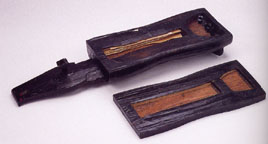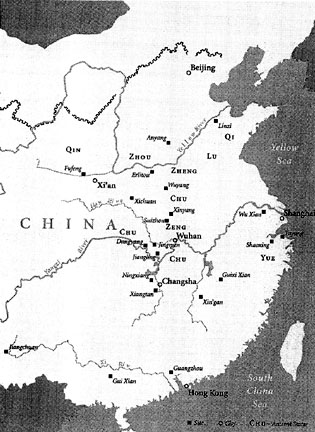| |
 Main Menu
Main Menu
選 項
Year 2000
Year 2001
Year 2002
Year 2003
| |
" Music in the Age of Confucius, "
an Exhibit of Ancient Instruments at the
Sackler Gallery (cont.)

|
|
Ten-stringed qin-zither and replica tuning pegs, from the tomb of
Marquis Yi of Zeng, Leigudun, Suizhou, Hubei Province. Fifth
century B.C. Carved lacquered wood. Length 67 cm, width 19
cm, depth 11.4 cm. Hubei Provincial Museum.
Photograph by John Tsantes.
|

|
|
View of qin with top and bottom separated and replica tuning
pegs in place.
Photograph by John Tsantes
|
|
Buried among this unique profusion of instruments
and their stands and storage boxes lay one small qin.
Quite small. Scarcely more than half the length of the
modem qin, this instrument is one of three early qin to
have been unearthed in modem times. So different are
they from the modem qin that they appear at face to be
a different instrument, and it has taken some analysis to
establish that old and new forms are relatives. The old
qin (a ku qin, literally) bears more overt resemblance to
a hand-held instrument like a violin or guitar than to a
zither, with a short, rectangular body, whose long sides
are indented in straight lines like the outline of a
geometric figure eight, and a wide, flat neck. Baffling
is the bottom, which matches in outline, but is not
attached to, the top. Absent from the catalog is much
backroom debate as to the position in which this
instrument was played and the role of its independent
bottom plate, which curator Jenny So and Bo
Lawergren outlined during the tour. The instrument has
a single anchor pin for the strings under the neck on the
left end and tuning pins for ten strings inside the body
on the right. These are the earliest extant examples of
tuning pins for any instrument, and, unlike today, they
were turned with a key.
Bo Lawergren wrote "Strings," the third chapter of
the exhibition catalog. Here, he summarizes
information on the three types of zither found in the
marquis' tomb (se, zhu, and qin) and also provides
information on the fourth zither popular in early times,
the zheng. The catalog is an excellent summary of the
state of knowledge on most of the instruments of early
times, an important document among those commonly
available on the subject in English.

|
|
Map showing major sites, cities, and relative
locations ancient states,
From Music in the Age of Confucius,
page 115
|
Neolithic Period ca.7000- 2000 B.C.
Bronze Age ca.2000-500B.C.
Shang dynasty ca. 1600-1050 B.C.
Zhou dynasty 1050-221 B.C.
Western Zhou 1050-771 B.C.
Eastern Zhou 771-221 B.C.
Warring States Period 480-221 B.C.
Qin dynasty 221-206 B.C.
Han dynasty 206 B.C.-A.D. 220
Western Jin dynasty A.D. 265-316
Tang dynasty A.D. 618-907
Song dynasty A.D. 960-1279
Northern Song A.D. 960-1127

|
|
Five-stringed zhu-zither, with detail, from the
tomb of Marquis Yi of Zeng, Leigudun,
Suizhou, Hubei Province. Fifth century B.C.
Carved lacquered wood. Length 115 cm, width
7 cm, depth 4 cm, Hubei Provincial Museum.
Photograph by Hao Qinjian.
|

|
|
detail.
|
In retrospect, the catalog and exhibit of " Music in
the Age of Confucius " constitute a vision of the
present state of ancient music.
Among the mysteries that
always multiply around
increased knowledge, they
provide us with as clear a view
as possible of what we now
know, and something of what
we do not know, about this
remote time; and especially, of
what we do not know about the
music itself. This is almost
certainly lost, forever reduced to
the written descriptions of its
sounds, instruments, and social
roles that still are found in
ancient texts, as well as to what
we may glean from the mute
peculiarities of its antique
artifacts. It is clear, however,
that music had an importance in
the world extreme beyond
anything like its place today.
Now, music reaches its deepest
significance inside the
solipsistic world of personal
experience, but anciently, up
through the Han at least, the
numerical relationships within
music were thought to embody
or reflect the natural essence of
the universe, including the
world of human experience.
Then, music harmonized the
world, just as, up to a few
centuries ago, the harmony of
the spheres regulated the
heavens of Europe. Today, what
we know of the old music from those who experienced
it is found in ancient reports like the Li Chi, or Record
of Ritual, which still reminds us of the meaning of
music and rites in distant times:
"Thus, music comes from within, and rites act from
without. Coming from within, music makes our minds
serene; acting from without, ritual makes our gestures
elegant. Yet, great music must be easy, and great rites, simple."
|

